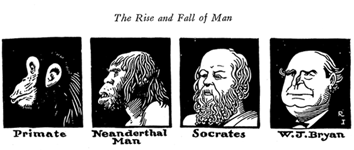Teaching the Article

True or false: Everyone knows why this is funny. Is it because we believe William Jennings Bryan actually de-volved? When we laugh at evolution jokes, is it because we know evolution is true? Or are we being ironic—do we intuitively doubt that evolution implies progress? Do such jokes give us a way to laugh at ourselves, at our own pretensions? (How silly of us to think we are superior to monkeys.) Why do we know the sequence refers to evolution, and why would readers in 1925 have known that? Why is the 1925 “cake-eater” cartoon funny even if we no longer know what a cake-eater is? Were these cartoons funny in 1925 in the same way that they are funny today?
Guiding students through images drawn from the evolution debates surrounding the 1925 Scopes trial allows me to convey two main themes. First, ideas we take for granted as obvious "common sense" have historical roots. Second, much of our common knowledge comes from ideas we associate with science, and historical analysis helps us explore the connections between such uses of science and values.
Talking about evolution jokes—and about jokes in general—helps unravel some of our assumptions about who we are and how we came to be that way, to put our ideas about ourselves in historical context. Adding the context of the debates of the early twentieth century helps us get at something more: the historical intertwining of the linear model of evolution with ideas about hierarchy in human relationships, especially ideas about race.
To show students how pervasive such ideas are, I ask them to define "civilization." Their initial definitions tend to describe some hybrid of modern North America and Victorian Britain, but with a little prodding, the discussion uncovers the value-laden nature of the concept. I tell them about the old idea of stages of civilization, the idea that there is an inevitable trajectory from primitive to civilized.
Showing them pictures from the world's fairs of the late nineteenth and early twentieth centuries , exhibitions intended to show the "progress" of civilization from Dahomey to Chicago, I read statements from the anthropology of the period. They describe "primitive" peoples as "the childhood of the race" and suggest that women, Africans, and Italians, for example, were similarly childlike and lower on the evolutionary scale than, oh, say, white male anthropologists. By the time we get to the 1920s, it's pretty clear that the idea of evolution has had political and cultural implications that are not simply the consequences of objective scientific method.
I then turn to scientists' attempts to depict evolution, for each other and for the public. Comparison of Charles Darwin's 1859 branching diagram with Ernst Haeckel's 1866 "Pedigree of Man" points to the history of the linear model of evolution that underlies the familiar cartoon sequence. Why is Haeckel's diagram called a "pedigree," and what does that term imply? Does Darwin's diagram have a direction and a pinnacle in the same way that Haeckel's tree does?
William King Gregory's 1931 diagram illustrates the assumption— taken for granted by scientists but not necessarily the general public—of a complex evolutionary history underlying the familiar linear sequence from monkeys to humans. Why did Gregory include "undiscovered ancestors" at the base of his diagram? What does their presence suggest about the scientific process and the contingency of scientific hypotheses? What happened to such elements in the linear visions of evolutionary sequence published in the debates with creationists?
I also call students' attention to the way evolutionary thinking contained mixed messages about basic human dignity and racial hierarchy. The magnificent painting of a Cro-Magnon cave artist, made by Charles R. Knight under the direction of the paleontologist Henry Fairfield Osborn for the American Museum of Natural History, attempts to counter the stereotypes of "cave men" as brutes. Such stereotypes of cave men, familiar in the late nineteenth century, became common in the 1920s in comic strips, newspaper articles, and advertisements. Knight and Osborn, deeply impressed by the subtlety and sophistication of Cro-Magnon cave paintings, intended the mural to convey the dignity and grandeur of human evolution.
After discussing the implications of Knight's image, I show my students an evolutionary tree diagram designed by Osborn , a variation on a diagram he sent to the Scopes trial to persuade the jury and the public of the truth of evolution. Is this a branching diagram, or does it imply a linear "racial" hierarchy? Remembering how Osborn used the Cro-Magnon cave artist to demonstrate the nobility of human origins, locate the Cro-Magnon artist on the chart. Who, according to the diagram, is actually descended from the Cro-Magnon cave artist and who is not?
Our students have heard many times about racism in American life; if they are history majors, they have heard about racism in the 1920s. To discover it incorporated into diagrams claiming to illustrate objective scientific truth, however, may have an impact that the familiar assertions do not, provoking students to ask their own questions about science, its history, and its relationship to the ideas we think of as common sense.
- Constance Areson Clark
